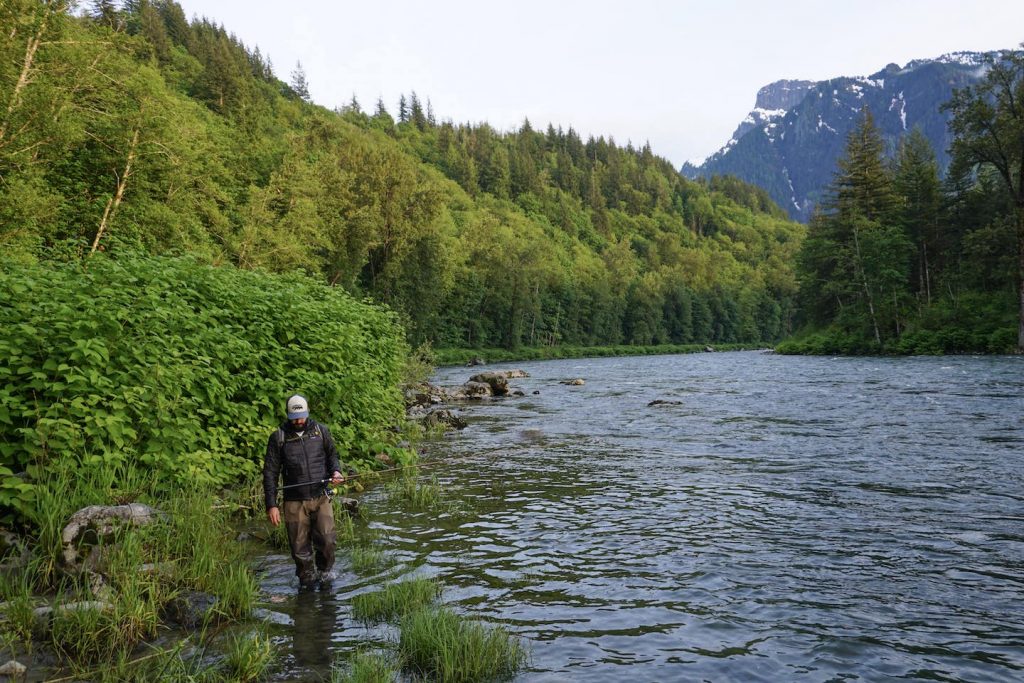
WFC Sues WDFW Over South Fork Skykomish Summer Steelhead Program
Despite a written assurance from WDFW’s director that he wouldn’t release steelhead smolts reared for a new Skykomish River hatchery program without final federal go-ahead, a highly litigious environmental group sued the agency last week anyway.

The Wild Fish Conservancy claims that WDFW is violating the Endangered Species Act by collecting, holding and spawning listed fish for the project and it is asking U.S. District Court in Seattle to enjoin it and for an injunction until coverage is issued.
It’s been dubbed the Duvall-based outfit’s “perhaps … most shameful lawsuit yet” because it puts the continuation of Puget Sound’s last, best summer-run fishery at increased risk, stresses a wider accord that has been reached by Westside steelheaders of all stripes – WDFW’s QuickSilver Portfolio – and comes at a critical juncture for the fish and their fans and strongest advocates.
Essentially, WFC is following up its lawsuit that torpedoed the existing summer program on the popular Skykomish with another salvo targeting the replacement plan.
Under the 2019 settlement with the organization, WDFW agreed to quit stocking out-of-basin Skamania-strain steelhead in the river in spring 2022 with a final release of 40,000 smolts.

Meanwhile, after pushing from the feds, the state agency and Tulalip Tribes announced plans in 2019 to switch over to natural-origin summer-runs that return to a trap below impassable Sunset Falls.
Those fish are the offspring of a long intermixing of hatchery and wild steelhead that since 1958 have been trucked around the falls into the upper South Fork Skykomish to utilize fish habitat there, and they actually aren’t even covered under ESA.
WFC’s lawsuit, however, claims it is “almost certain” that some summer-runs that turn up at Sunset Falls originate in the North Fork Sky and thus fall under federal protections.
Per their claims and WDFW records, 52 steelhead collected at the falls yielded a total of 101,300 eggs in early 2020, with 29 of those fish lethally spawned in the process.
In its defense, WDFW says it received a “letter of sufficiency” from the National Marine Fisheries Service in June 2019 for the program’s state-tribal hatchery genetic management plan, or HGMP, and the agency points out that this past December NMFS concluded that “as described [the program] would not appreciably reduce the likelihood of survival and recovery of affected ESA-listed species.”
The plan calls for an annual release of up to 116,000 smolts – including up to 56,000 this spring – in support of tribal treaty rights, provide for state fisheries and to help recover wild steelhead in the North Fork. Currently, North Fork fish have a high proportion of Skamania genes but South Fork steelies are a more productive summer stock and are “likely considerably more locally adapted,” per the state and feds.
A legal observer speculated that WDFW could have a good argument that releasing the natural-origin South Fork smolts wouldn’t irreparably harm wild fish, and they might even benefit them.
And now, with a draft environmental assessment out for public review through early March, WDFW Director Kelly Susewind said the new integrated broodstock program is “well down the path toward securing ESA coverage.”
“While we cannot guarantee NMFS will approve the HGMP for this program, all indications are that a biological opinion will be completed early this year,” Susewind wrote to WFC’s Kurt Beardslee in a Feb. 5 letter trying to head off the lawsuit.

Five days later, WFC filed one.
“WDFW must be held accountable for blatantly operating this program in violation of the Endangered Species Act and other environmental laws,” said Beardslee in a press release two days later. “The pattern and practice of WDFW repeatedly breaking the laws it expects everyone else to follow is unacceptable.”
In his letter, Susewind said he was “frankly disappointed” WFC had threatened his agency in December with the lawsuit, and he took umbrage with their portrayal of WDFW steelhead hatchery management.
“The Department has undertaken substantial revisions to both fishery and hatchery management with a view to securing steelhead conservation. The hatchery programs in effect at the time of the steelhead listing were dramatically scaled back and reconfigured to address potential risks to wild steelhead. We have worked closely with tribal co-managers, the public, NMFS, and with the U.S. Fish and Wildlife Service to ensure hatchery operations are responsive to Endangered Species Act considerations. The proposed replacement of a non-local, Columbia River stock with one originating from the Skykomish River is yet another action to reduce the potential risks of hatchery programs and contribute to the conservation of Puget Sound steelhead,” Susewind wrote.
Indeed, steelheading in the region has a very different look than back in the day in response to 2007’s threatened listing for Puget Sound stocks.
Where once summer and winter hatchery smolts were released into streams such as the Tolt, Raging, Sultan, South Fork Stillaguamish, Canyon Creek and others for dispersed recreational consumptive fisheries, today only a handful of rivers with collection facilities receive any, and hatchery operators grade towards early-arriving fish to separate them in time as much as possible from natives.
Yet while WDFW has pared back its hatchery operations considerably, WFC has pursued low-hanging-fruit litigation, repeatedly going after the agency’s lack of federal paperwork, primarily in the form of those HGMPs.
Those have been missing due in no small part to NMFS’s workload given all the listings these days and competing demand for ESA coverage, and this latest WFC lawsuit appears to be from that same old tired playbook.
Susewind’s letter points out the incongruity in how WFC has “urged” WDFW to get federal permits for its hatchery programs that overlap ESA-listed runs, stating that the agency has acted “diligently for the proposed Skykomish Summer Steelhead program and, with the end of that process now close at hand, we are perplexed why the WFC would now consider litigation.”
One possible answer is to use the court system to possibly force hatchery managers to again release smolts into landlocked lakes, like what happened in 2014 with the WFC-WDFW settlement over Chambers Creek early winter steelhead smolts and which put a hole in several fisheries for a couple years.

Hatchery managers have a narrow timeframe in spring to release young steelhead. If they have to hang onto them too long, the fish “residualize,” meaning they won’t go to sea. Steelheaders would rather catch their quarry as returning ocean-fed adults in the Sky than on Green Lake as just another stocker rainbow trout.
Still, WDFW has to play by ESA rules – along with Puget Sound steelhead, Chinook and bull trout are also listed and must be considered in planning – and can’t put itself in serious legal jeopardy.
“The Department does not plan to release the smolts from the Skykomish Summer Steelhead hatchery program into the Skykomish River unless and until a biological opinion has been completed by NMFS,” Susewind wrote to Beardslee. “As noted above, we expect that approval will likely arrive before the release window for steelhead smolts this spring.”
The legal observer speculated that if WFC to pursue a preliminary injunction, that would raise questions about what happens to the program’s smolts and adults. They also suggested a local fishing group intervene in the lawsuit to try and help ensure WDFW doesn’t cave in and accept another poor settlement.
Meanwhile, public input on the draft environmental assessment, or EA, is open through March 8 and steelheaders are being encouraged to do so.
Over 800 comments poured in in December and January for the proposed evaluation and pending determination, or PEPD, for the South Fork summer-run broodstock program and an associated trap and haul program at Sunset Falls, including a letter from 12 members of WDFW’s Puget Sound Steelhead Advisory Group.
“It is vital for the future viability of the sportfishing community, tribal treaty obligations, and our state prestige that Puget Sound steelhead populations do not become listed as ‘Endangered’ under the Endangered Species Act. We believe that this program, as part of the Quicksilver Portfolio, provides an effective path toward conserving wild steelhead, restoring fishing opportunities, and creating a future in which the tradition of steelhead fishing is continued and passed on to future generations,” wrote Mark Spada of the Snohomish Sportsmen’s Club, Al Senyohl of the Steelhead Trout Club of Washington, Rich Simms of the Wild Steelhead Coalition, Jonathan Stumpf and Rob Masonis of Trout Unlimited, retired WDFW biologist Curt Kraemer, as well as members of the Wildcat Steelhead Club and Coastal Conservation Association, and even Derek Day of the Native Fish Society.
Public comment can be emailed to hatcheries.public.comment@noaa.gov with the subject line: Comments on the Environmental Assessment for the Skykomish River hatchery program and/or Sunset Falls trap and haul program.
Or mailed to:
Emi Melton
NMFS, West Coast Regional Office
1201 NE Lloyd Blvd., Suite 1100
Portland, OR 97232
